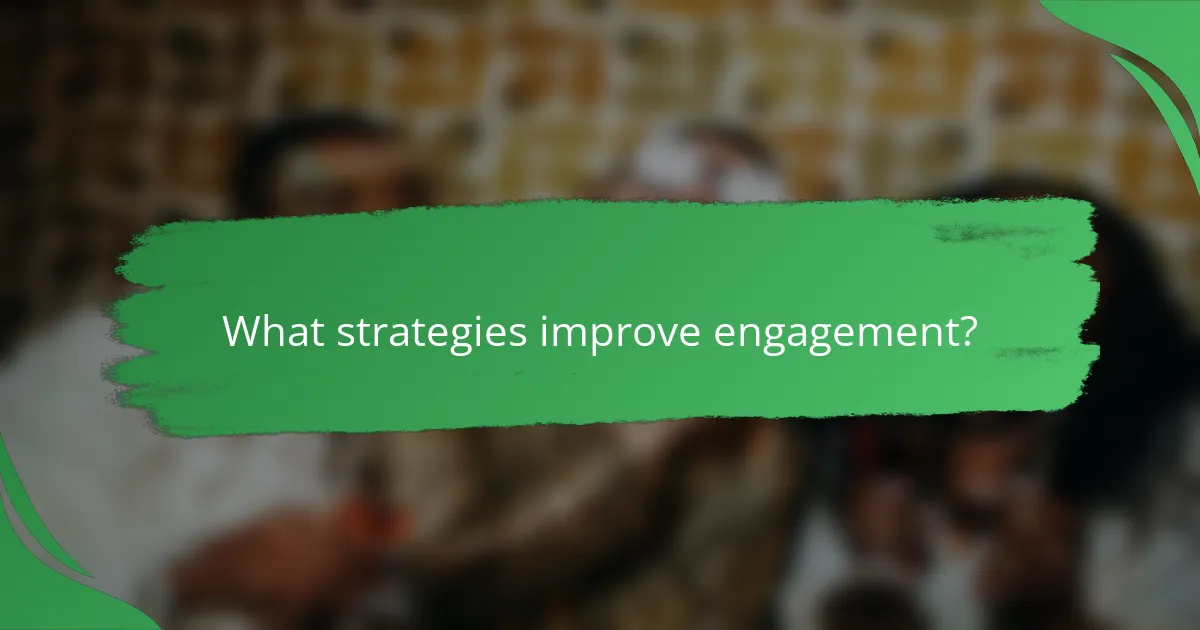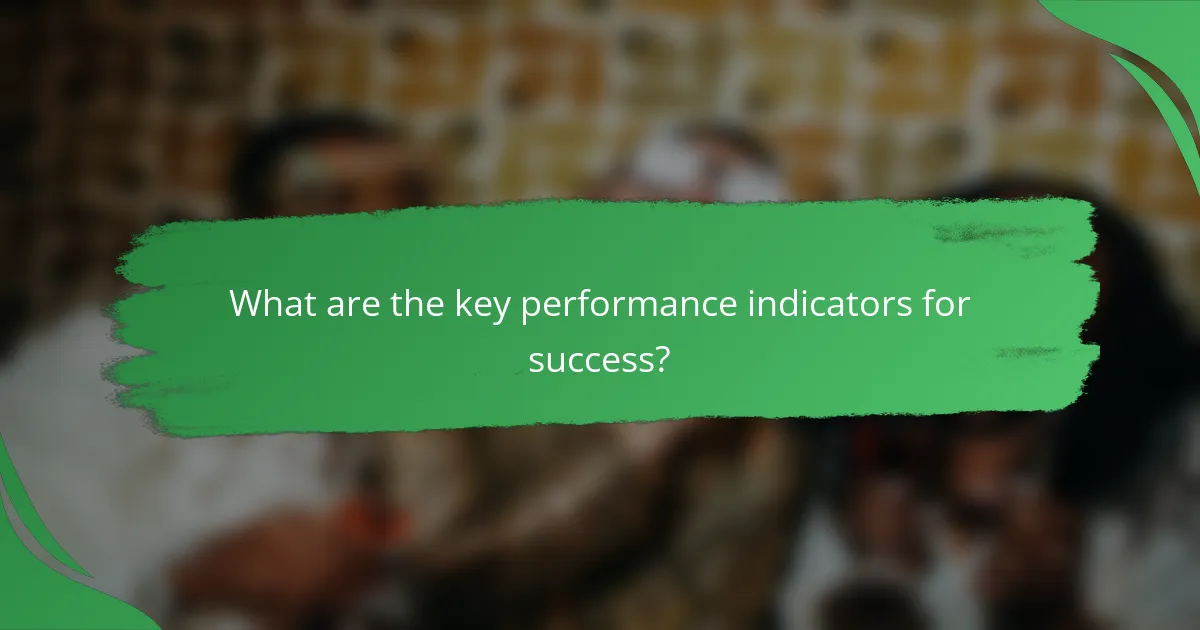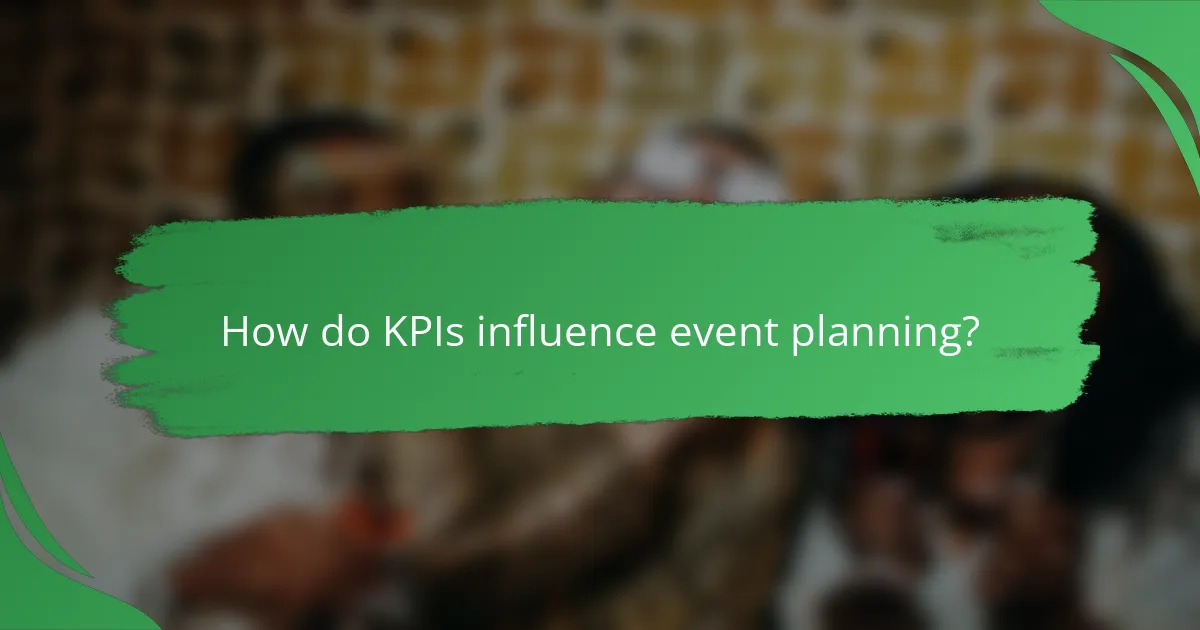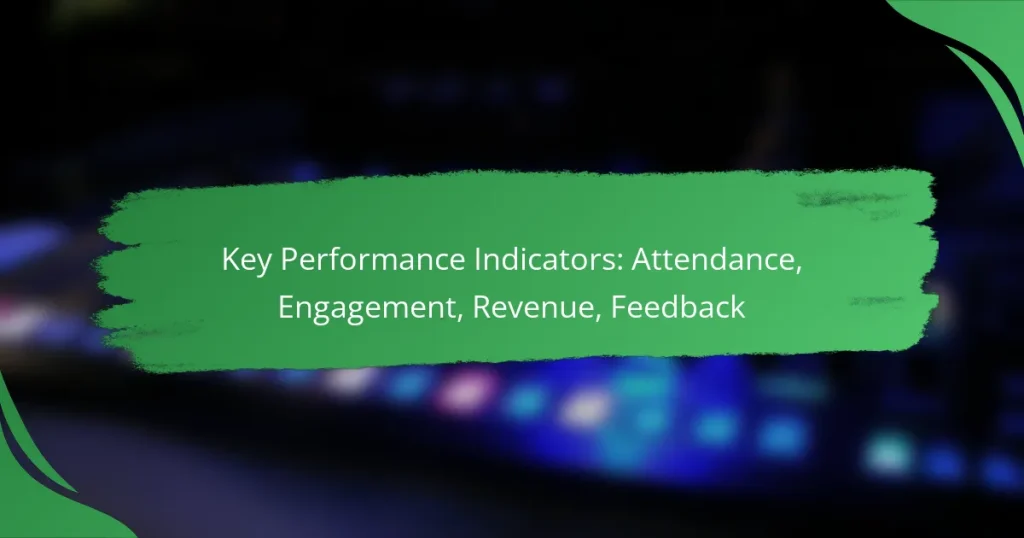Key Performance Indicators (KPIs) are essential for evaluating the success of events, focusing on metrics such as attendance, engagement, revenue, and feedback. By analyzing attendance data and participant interactions, organizations can gain valuable insights into event effectiveness and areas for improvement. Additionally, understanding revenue streams and gathering participant feedback are crucial for optimizing future events and enhancing overall satisfaction.

How can attendance be measured effectively?
Effective measurement of attendance involves tracking various metrics that provide insights into participant engagement and event success. Key methods include analyzing event registration data, check-in statistics, and ticket sales performance.
Event registration metrics
Event registration metrics are crucial for understanding potential attendance. This includes the total number of registrations, the demographics of registrants, and the conversion rate from interest to actual sign-ups. Tracking these metrics helps identify trends and target marketing efforts effectively.
For instance, if a conference has 500 registrations but only 300 attendees, the conversion rate is 60%. This insight can prompt organizers to improve follow-up communications or incentives to boost attendance.
Check-in statistics
Check-in statistics provide real-time data on who actually attends the event. This can be measured through physical check-in systems or digital platforms that track attendance. Monitoring check-in rates helps assess the effectiveness of event marketing and logistics.
For example, if an event expects 400 attendees but only 250 check in, it indicates a potential issue with engagement or scheduling. Organizers can use this information to adjust future events or improve attendee experience.
Ticket sales analysis
Ticket sales analysis is a vital component of measuring attendance, especially for paid events. This includes examining the number of tickets sold, revenue generated, and any patterns in sales over time. Understanding these metrics can help in pricing strategies and promotional efforts.
For example, if early bird tickets sell well but last-minute sales are low, it may suggest a need for better marketing as the event date approaches. Organizers should consider offering discounts or additional incentives to boost late sales.

What strategies improve engagement?
Improving engagement requires a multifaceted approach that incorporates interactive elements, social media, and gamification. These strategies can significantly enhance user participation and satisfaction, leading to better overall performance metrics.
Interactive content utilization
Interactive content, such as quizzes, polls, and surveys, can effectively boost engagement by encouraging users to participate actively. This type of content not only captures attention but also provides valuable insights into user preferences and behaviors.
To implement interactive content, consider using tools that allow for easy creation and integration into your existing platforms. Aim for a balance between entertainment and information to keep users engaged without overwhelming them.
Social media integration
Integrating social media into your engagement strategy can amplify reach and foster community interaction. By sharing content across platforms like Facebook, Twitter, and Instagram, you can encourage users to engage with your brand in various ways, such as sharing, commenting, or liking.
Ensure that your social media posts are tailored to each platform’s audience and format. Utilize hashtags and encourage user-generated content to enhance visibility and interaction. Regularly analyze engagement metrics to refine your approach.
Gamification techniques
Gamification involves incorporating game-like elements into non-game contexts to enhance user engagement. Techniques such as point systems, leaderboards, and rewards can motivate users to participate more actively and consistently.
When applying gamification, focus on creating achievable goals and meaningful rewards to maintain user interest. Be cautious not to make the system too complex, as this can lead to frustration rather than engagement. Regularly assess user feedback to optimize the gamification experience.

How is revenue generated from events?
Revenue from events is primarily generated through ticket sales, sponsorships, and merchandise. Each of these revenue streams plays a crucial role in the overall financial success of an event, and understanding their dynamics is essential for effective planning and execution.
Ticket pricing models
Ticket pricing models determine how much attendees will pay to participate in an event. Common strategies include tiered pricing, where different price levels are set based on seating or access levels, and early-bird discounts that incentivize advance purchases.
For example, a concert might offer general admission tickets at a lower price while providing VIP packages that include perks like meet-and-greets at a premium. It’s important to analyze your target audience and competitor pricing to find the right balance that maximizes attendance and revenue.
Sponsorship opportunities
Sponsorships can significantly boost event revenue by partnering with businesses that want to gain exposure. Companies often pay to have their logos displayed, sponsor specific activities, or provide branded materials in exchange for visibility to attendees.
When seeking sponsors, consider creating tiered sponsorship packages that offer varying levels of exposure, from logo placement on promotional materials to exclusive sponsorship of key event segments. Tailor your pitch to align with potential sponsors’ marketing goals and audience demographics.
Merchandise sales
Merchandise sales provide an additional revenue stream by selling branded products related to the event. Items can range from apparel and accessories to memorabilia that attendees may want to take home as a reminder of their experience.
To maximize merchandise sales, ensure that products are high-quality and relevant to the event theme. Consider offering exclusive items that can only be purchased at the event, and set up attractive displays to encourage impulse buys. Pricing should reflect both the cost of production and the perceived value to attendees.

What feedback mechanisms are most effective?
Effective feedback mechanisms include post-event surveys, real-time feedback tools, and focus group discussions. Each method offers unique insights into attendee experiences and can significantly enhance future events.
Post-event surveys
Post-event surveys are a common method for gathering feedback after an event concludes. They typically consist of structured questions that assess various aspects such as content quality, speaker effectiveness, and overall satisfaction.
To maximize response rates, consider keeping surveys concise, ideally under 10 questions. Offering incentives, like discounts on future events, can also encourage participation.
Real-time feedback tools
Real-time feedback tools allow attendees to share their thoughts during the event. These can include mobile apps or platforms that enable instant polling and comments, providing immediate insights into participant engagement.
Using these tools can help event organizers make on-the-fly adjustments, such as changing session formats or addressing concerns. However, ensure that the technology is user-friendly to avoid frustrating attendees.
Focus group discussions
Focus group discussions involve small groups of attendees who provide in-depth feedback about their experiences. This qualitative approach allows for deeper exploration of specific topics, such as content relevance and logistical issues.
To conduct effective focus groups, select a diverse range of participants and prepare open-ended questions that encourage discussion. Limit groups to 6-10 participants to facilitate meaningful dialogue and ensure everyone has a chance to contribute.

What are the key performance indicators for success?
Key performance indicators (KPIs) for success include attendance rates, engagement scores, revenue growth, and feedback metrics. These indicators help organizations assess their performance and identify areas for improvement.
Attendance rates
Attendance rates measure the percentage of participants who attend an event or engage with a service. High attendance rates often indicate strong interest and effective outreach strategies.
To calculate attendance rates, divide the number of attendees by the total number of invited participants, then multiply by 100. For example, if 80 out of 100 invitees attend, the attendance rate is 80%.
Consider setting benchmarks based on industry standards; for many events, a successful attendance rate ranges from 60% to 90%. Regularly track this KPI to identify trends and adjust marketing efforts accordingly.
Engagement scores
Engagement scores reflect how actively participants interact with content or services. These scores can include metrics like session duration, interaction frequency, and user feedback.
To improve engagement, focus on creating relevant content and fostering community interaction. Tools like surveys or analytics platforms can help quantify engagement levels, often expressed on a scale from 1 to 10.
Aim for engagement scores above 7 for positive outcomes. Regularly review these scores to refine your strategies and enhance participant involvement.
Revenue growth
Revenue growth measures the increase in income generated over a specific period. This KPI is crucial for assessing the financial health of an organization.
To calculate revenue growth, subtract the previous period’s revenue from the current period’s revenue, divide by the previous period’s revenue, and multiply by 100. For instance, if revenue increased from $100,000 to $120,000, the growth rate would be 20%.
Monitor revenue growth quarterly to identify patterns and make timely adjustments. A steady growth rate of 5% to 10% is often considered healthy, but this can vary by industry.

How do KPIs influence event planning?
Key Performance Indicators (KPIs) are essential metrics that help event planners assess the success of their events. By focusing on attendance, engagement, revenue, and feedback, planners can make informed decisions to enhance future events and achieve their objectives.
Attendance
Attendance is a fundamental KPI that indicates the number of participants at an event. Monitoring attendance helps planners understand the effectiveness of their marketing strategies and the appeal of the event content.
To improve attendance, consider using targeted promotions and early-bird ticket pricing. A common approach is to aim for a registration-to-attendance ratio of around 70-80%, which reflects a healthy level of interest and commitment.
Engagement
Engagement measures how actively participants interact with the event content and each other. High engagement levels often correlate with attendee satisfaction and can lead to positive word-of-mouth promotion.
To boost engagement, incorporate interactive elements such as Q&A sessions, polls, and networking opportunities. Tracking engagement can involve monitoring session participation rates and social media interactions during the event.
Revenue
Revenue is a critical KPI that reflects the financial success of an event. It includes ticket sales, sponsorships, merchandise, and any additional income generated.
To maximize revenue, set clear pricing strategies and explore diverse revenue streams. A well-planned event budget should aim for a profit margin of at least 20-30% to ensure sustainability for future events.
Feedback
Feedback provides valuable insights into attendee experiences and perceptions of the event. Collecting feedback helps identify strengths and areas for improvement.
Utilize post-event surveys to gather participant opinions, aiming for a response rate of around 20-30%. Focus on specific questions regarding content quality, logistics, and overall satisfaction to gather actionable data for future planning.


